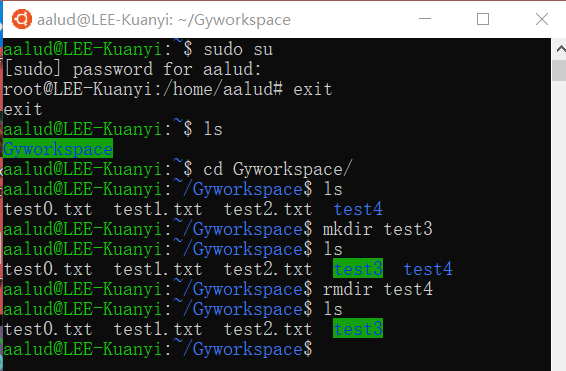姓名:李冠毅 学号:201822121031 班级:计算1811
目录
一、实验目的
熟练Linux命令行操作
二、实验内容
- 使用
man查询命令使用手册 - 基本命令使用
三、实验报告
1. 实验环境介绍
- 操作系统:Ubuntu 18.04.3 LTS
- 平台:双操作系统
2. 常用命令使用

3. 剖析ps命令
运行man ps,将ps使用方法拷贝过来
1 NAME 2 ps - report a snapshot of the current 3 processes. 4 5 SYNOPSIS 6 ps [options] 7 8 DESCRIPTION 9 ps displays information about a selection of 10 the active processes. If you want a 11 repetitive update of the selection and the 12 displayed information, use top(1) instead. 13 14 This version of ps accepts several kinds of 15 options: 16 17 1 UNIX options, which may be grouped and 18 must be preceded by a dash. 19 2 BSD options, which may be grouped and 20 must not be used with a dash. 21 3 GNU long options, which are preceded by 22 two dashes. 23 24 Options of different types may be freely 25 mixed, but conflicts can appear. There are 26 some synonymous options, which are 27 functionally identical, due to the many 28 standards and ps implementations that this ps 29 is compatible with. 30 31 Note that "ps -aux" is distinct from 32 "ps aux". The POSIX and UNIX standards 33 require that "ps -aux" print all processes 34 owned by a user named "x", as well as 35 printing all processes that would be selected 36 by the -a option. If the user named "x" does 37 not exist, this ps may interpret the command 38 as "ps aux" instead and print a warning. 39 This behavior is intended to aid in 40 transitioning old scripts and habits. It is 41 fragile, subject to change, and thus should 42 not be relied upon.
运行命令ps -ef
1 UID PID PPID C STIME TTY TIME CMD 2 root 1 0 0 13:04 ? 00:00:00 /init 3 root 7 1 0 13:04 tty1 00:00:00 /init 4 aalud 8 7 0 13:04 tty1 00:00:00 -bash 5 aalud 84 8 0 13:19 tty1 00:00:00 ps -ef
-
- UID:用户ID
- PID:进程ID号
- PPID:父进程ID号
- C:cpu使用的资源百分比
- STIME:系统时间
- TTY:该进程是在哪个终端机上运行,若与终端机无关则显示“?”
tty1-tty6是本机上的登入者程序,若为pts/0等则为由网络连接进主机的程序 - TIME:使用掉的cpu时间
- CMD:所下达的指令名称
运行ps -aux
1 USER PID %CPU %MEM VSZ RSS TTY STAT START TIME COMMAND 2 root 1 0.0 0.0 8892 292 ? Ssl 13:04 0:00 /init 3 root 7 0.0 0.0 8900 208 tty1 Ss 13:04 0:00 /init 4 aalud 8 0.0 0.0 16792 3380 tty1 S 13:04 0:00 -bash 5 aalud 85 0.0 0.0 17648 2052 tty1 R 13:26 0:00 ps -aux
-
- USER:该进程属于哪个使用者ID
- %CPU:该进程使用的CPU资源%
- %MEM:该进程占用的物理内存%
- VSZ:该进程使用的虚拟内存量
- RSS:该进程占用的固定内存量
- STAT:该程序目前状态
- START:该进程被触发的启动时间
- COMMAND:该程序的实际指令
4. 通过该实验产生新的疑问及解答
由于ubuntu是在该课程前就安装的,所以用户名是自己的ID。然后老师要求前缀要带自己姓名,所以就直接改了主机名,方法:计算机→属性→计算机名更改设置→更改→输入名→确认→重启电脑→修改生效。


 浙公网安备 33010602011771号
浙公网安备 33010602011771号